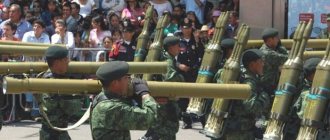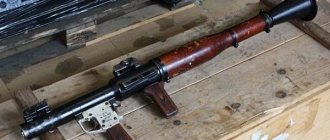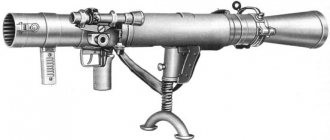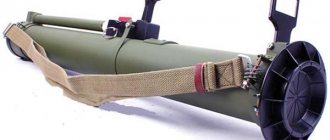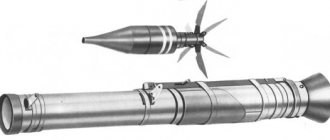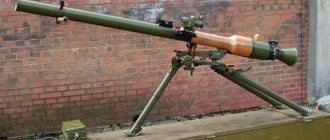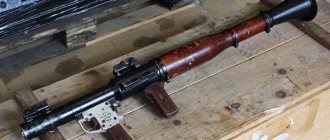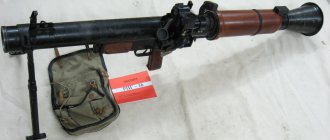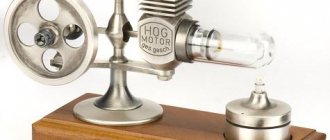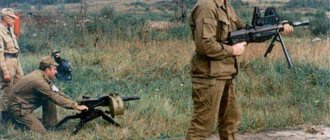A hand grenade launcher is a powerful individual weapon for a fighter. With the help of a grenade launcher, he can protect himself from enemy tanks and armored vehicles. Having a relatively low cost, a hand grenade launcher can destroy an enemy tank or armored vehicle that costs several million dollars. At the same time, hand grenade launchers are very simple weapons and do not require highly qualified fighters. The famous RPG-7 became the favorite weapon of various partisans and rebels. There are confirmed cases of RPG-7 hitting even low-flying helicopters.
True, there is one “but”. Recently, the protection of tanks and armored vehicles has made great progress, and it is already quite difficult to destroy a tank with a hand grenade launcher. Modern tanks have received multi-layer armor, with the addition of ceramics, built-in dynamic protection systems, active protection systems and an honored veteran, the RPG-7 is no longer very effective against them. Especially if older types of grenades are used.
For example, American and British tanks in Iraq withstood up to fifteen hits from RPG-7 grenades and left the battlefield under their own power. In Chechnya, to knock out Russian tanks, the separatists needed 7-8 hits on the vehicle. Therefore, the idea of developing a new anti-tank grenade launcher, which would replace the excellent, reliable, but already outdated RPG-7, was simply in the air.
In the Soviet Union, and then in Russia, the main center for the development and production of grenade launchers is the Basalt Research and Production Enterprise, where the famous RPG-7 and a number of other excellent anti-tank weapons were created. One of the latest developments of Basalt was the RPG-32 rocket-propelled anti-tank grenade launcher, also known as Hashim. This grenade launcher has already become legendary and is considered the most powerful in the world. It is capable of penetrating homogeneous armor meter thick.
Description of the grenade launcher and the history of its creation
RPG-32 has such a strange name for the Slavic ear because it was developed for the Jordanian armed forces. This grenade launcher was supposed to be produced in this Arab country under license and even exported to other countries. This is a joint Russian-Jordanian project. It must be said that it took eight long years to complete this project - the joint venture began its work only in 2013.
The development of this fundamentally new grenade launcher began in 2005 and lasted for two years. The RPG-32 was first presented to the general public in 2008 at an arms exhibition in Paris, where it was a stunning success. It is said that the name "Hashim" was given to the grenade launcher by the Jordanian King Abdullah himself, after he saw what this new weapon could do. “Hashim” is the generic name of the entire royal dynasty of Jordan and also of the prophet Muhammad. There are rumors that His Majesty personally developed the requirements for the new grenade launcher and what happened completely satisfied him.
This grenade launcher is currently being produced in Jordan. At the end of 2013, the production of these weapons was inaugurated at the JRESCO plant. Mexico is seriously interested in this grenade launcher and negotiations are currently underway. Brazil has also shown its interest in these weapons. This complex has not yet been adopted by the Russian army.
RPG-32 "Hashim" can be safely called a multi-purpose rocket-propelled hand grenade launcher. The RPG-7 is exactly the same weapon, but the Hashim performs its tasks at a different, modern level. The main task of this grenade launcher is to destroy enemy tanks and armored vehicles, but the RPG-7 can also successfully fight enemy infantry. Moreover, the RPG-32 is the world's first multi-caliber grenade launcher system, that is, it can fire grenades of various calibers, depending on the selected target. The RPG-32 is equipped with a special system that deceives the active protection of the tank. It releases a decoy ammunition, which triggers the protection when the grenade hits the target.
The grenade launcher consists of a launcher connected to an aiming device and disposable containers containing grenades. After the shot, such a container is thrown away. The containers are assembled and equipped at the factory and the fighter only needs to connect these parts, aim them at the target and fire a shot. Usually a collimator sight is installed on the grenade launcher, but if desired, you can install an optical or night vision sight.
In fact, it's very convenient. The fighter himself chooses exactly the shot that he needs to use in a particular case.
The lifespan of each launcher is two hundred shots.
The grenade launcher is called multifunctional because it can hit not only enemy armored vehicles, but also long-term firing points, bunkers and infantry in shelters or under armor protection. For this, different types of ammunition are used: cumulative (to destroy enemy armored vehicles) and thermobaric (to destroy manpower and various types of fortifications).
The newest RPG
After the appearance of the reusable RPG-7 in service with the Soviet and Russian armies, no worthy replacement for the legendary “seven” appeared. The most modern domestic development of this class today is the RPG-32
. At the same time, the grenade launcher itself has become an exclusively export product and is not used by Russian security forces.
Turnkey export project
The development of a new generation of hand-held anti-tank grenade launchers (RPGs) first became known in 2006 at the SOFEX exhibition. A year earlier, the Basalt enterprise, the leading Russian developer of anti-tank grenade launchers, began work on the RPG-32, commissioned by Jordan and financed by it. The joint project included not only the creation of a grenade launcher complex, but also the construction of a joint assembly plant in Jordan for the production of finished products. The project was named "Hashim" in honor of the ruling Jordanian royal dynasty of the Hashemites.
RPG-32 is a reusable grenade launcher, which differs from the classic and familiar domestic RPGs of the same class. The triggering device is a compact unit on which optical instruments and a firing mechanism are mounted. It is also accompanied by special cartridges with ammunition. This option allows the use of rocket-propelled grenades of various calibers - for example 72.5 mm or 105 mm. This allows you to select the required grenade launcher ammunition depending on the task at hand or the current situation.
A Jordanian soldier fires a 105-mm PG-32V round from an RPG-32 rostec.ru
The RPG-32 kit can include two types of shots: anti-tank cumulative PG-32V and thermobaric TBG-32V. A container with a thermobaric grenade is additionally marked with one or two orange stripes. The 105-mm PG-32V round is identical in design and characteristics to the RPG-27 or PG-7VR, and the TBG-32V of the same caliber is an analogue of the RShG-1 or TBG-7V. In a smaller caliber, such shots can replace the RPG-26 and RShG-2. Essentially, the RPG-32 modular grenade launcher system combines four types of standard close-combat ammunition with the ability to select any of them.
For aiming, the grenade launcher is equipped with a standard 1P81 day sight, which has the ability to make adjustments depending on the type of shot and the ambient temperature. During transportation and stowage, the 1P81 sight can be stored inside the 6G40 launcher. The launcher itself can withstand about 200 shots from any type of grenade.
RPG-32 grenade launcher complete with 72 mm TBG-32V round otvaga2004.ru
As already mentioned, a joint Russian-Jordanian venture was created to implement the ambitious project, and a large-scale advertising campaign began in the media. In the late 2000s and early 2010s, news about the RPG-32 Hashim project appeared with enviable regularity, experimental products were demonstrated at various international exhibitions, but the completion of the high-profile project was constantly postponed to a later date.
Anti-tank "Crossbow"
Over time, references to the joint Russian-Jordanian company JRESCO disappeared from advertising. The project was renamed “Nashshab” (translated from Arabic as “crossbow” or “destroying”), and today the manufacturer of the RPG-32 is Jadara Equipment & Defense Systems, specially created for these purposes. Gradually, a new grenade launcher began to appear in the military chronicles of the troubled Middle East region - the use of the RPG-32 was noted not only in Jordan, but also in Libya, Egypt, Iraq, Yemen, and the UAE.
Assembly of RPG-32 at a plant in Jordan rostec.ru
The completion of the full range of works of the joint Russian-Jordanian project was planned for two years, but then was postponed to 2009, which also did not happen. Just at this time, a corruption scandal broke out at the Basalt enterprise, as a result of which the director and general designer received suspended prison sentences. Against this background, intellectual property problems arose in relation to the RPG-32 grenade launcher. The production of system components was completely transferred to the Kirov JSC Novo-Vyatka.
In this regard, the deployment of mass production in Jordan was delayed for several years. During this period, the grenade launcher was slightly modified and modernized. The 72.5 mm caliber variant disappeared from advertising brochures. The grand opening of the production of Nashshab grenade launchers took place on May 30, 2013. At the same time, we are not talking about the full production cycle, but only about the final assembly of grenade launchers from Russian components.
PUI-32 kit: UPI-32 launcher and IRG-32V round tass.ru
For training shooting, Basalt specialists developed a training version of the PUI-32 grenade launcher, including a UPI-32 launcher and an IRG-32V shot simulator. This option makes it possible to conduct training simulating real combat firing with 42-mm IRG-32 grenades at a lower cost compared to classic inert ammunition.
Patents for ammunition components belong to Basalt, and one of the patents for a grenade launcher system is issued to OJSC Tulatochmash. Probably, it is the specialists from Tulatochmash who are involved in the development of the starting device. This is somewhat unusual, since specialized enterprises for these purposes have always had another Tula enterprise - the Central Design Research Bureau of Sports and Hunting Weapons (TsKIBSOO). At the same time, it is Tulatochmash that for many years has been engaged in the serial production of launching devices for RPGs developed at TsKIBSOO.
Belarusian trace
There is also a Belarusian trace in the history of the Russian-Jordanian grenade launcher. The standard daytime optical sight 1P81 (PGK-1) was developed and produced by the Belarusian holding BelOMO. In addition to the PGK-1 (GS-1DN) kit, Belarusian specialists added the GPD-1 (GS-2R) sight with a built-in ballistic computer and laser rangefinder. These sights can be equipped with NV/A-1 or NV/A-2 night attachments, as well as a TC/A-1 thermal imaging device.
Set of RPG-32 “Nashshab” grenade launcher system, 2013 jadara.jo
As the Jordanian side notes, the Belarusian enterprise, which won an open tender for the development of optics, was able to provide high-quality products at a reasonable price, while promptly making the necessary changes as the project was modernized. Also, by the efforts of Belarusian engineers, the complete set of the Nashshab grenade launcher included the JR-SIM-32 electronic simulator, which allows grenade launchers to be trained in firing from RPG-7, RPG-29 and RPG-32. It provides a three-dimensional visual interactive picture of the area and simulates various conditions, visual and sound effects.
A further development of the grenade launcher was the remote-controlled QUAD complex, which is an installation of quad RPG-32 grenade launchers. In the QUAD-1 version it can be mounted on a tripod stand, and in the QUAD-2 version it can be mounted on the roof of a lightly armored vehicle. The development of such a complex was also carried out by specialists from the scientific and technical holding BelOMO. To control the four grenade launchers, the Izumrud optical-electronic system with a GS-TV rangefinder sight is used.
Installation of QUAD-2 at the Milex-2017 exhibition. Photo by the author
RPG-34 or “Mixture”
It is worth noting that all elements of the export project received GRAU indices: grenade launcher - 6G40, transport and launch container - 6G41, shots - 7P65 and 7P66, optical sight - 1P81. All this indicates interest in the product on the part of the Russian Ministry of Defense and a direct attitude towards it. At the end of the 2000s, the press repeatedly wrote about the interest in the grenade launcher system on the part of representatives of official army structures. The name of the domestic R&D “Barkaz” for the development of the RPG-32 in the interests of the GRAU has appeared on the Internet. However, there is still no information about the adoption of the RPG-32 into service by the Russian army.
Some experts associate this state of affairs with the personality of the former director of Basalt V.V. Korenkov, who headed the development of the RPG-32 and was fired from this post in the midst of work on the grenade launcher. It was after his departure that the process of finalizing the complex slowed down greatly, and over time the grenade launcher finally left the Russian domestic market. Others claim that he “pulled the blanket” to himself in a new place, leading the development of a more promising grenade launcher. However, in addition to the 61-mm small-sized RPG-34 project, developed at MSTU. N.E. Bauman under his leadership, there is no other information about this direction.
Demonstration of the development of promising Russian grenade launchers forum.guns.ru
It is more likely that the GRAU immediately relied on a more promising grenade launcher system, which is being developed within the framework of the Mixture design and development project as part of the third generation Sotnik (Ratnik-3) equipment. There is very little data about a new development that leaks into the public space and periodically changes over time. Recently it has been reported that the complex will include anti-tank and thermobaric ammunition of 72.5 mm caliber - this was the caliber of the RPG-22 and the still produced RPG-26. Probably, the latter should be replaced by a new generation of grenade launcher.
The promising 6S20 complex will also include a launcher, which is a reusable element with a mount for optical instruments.
It will be accompanied by containers with finally equipped grenades. This concept largely replicates the RPG-32 device. In addition to using the modular design of the product, the ammunition itself, as well as the sighting system, will be modernized. It is planned to complete testing of the new RPG by the end of 2022, and to launch mass production by 2023 at the Nizhny Tagil chemical plant. Technical characteristics of the complex
| RPG-32 | PG-32V | TBG-32V | PGK-1 | |
| Index | 6G40 | 7P65 | 7P66 | 1P81 |
| Caliber (diameter), mm | 105 | 72 / 105 | 105 | 122,5 |
| Length, mm | 375* / 1200 | 900 / 1000 | 1000 | 195 |
| Weight, kg | 3* / 11,5 | 3 / 7,5 | 7,5 | 1,5 |
| Initial speed of the grenade, m/s | 140 | 140 | 140 | – |
| Effective firing range, m | 500-700 | 500 | 700 | – |
| Armor penetration, mm including behind dynamic protection, mm reinforced concrete wall, mm brick wall, mm | – | 500 / 750 440 / 650 1500 2000 | – | – |
* - characteristics of the launcher with an optical sight 1P81
Literature:
- V.G. Boychenko, V.G. Smelikov. Mastyazhart - GSKB-47 - FSUE "GNPP "Basalt". — M.: “Association “LSOP”, 2011
- E.N. Nikulin, V.F. Russkov, I.A. Semenov. Melee weapons. Hand grenade launchers. - St. Petersburg: BSTU "Voenmech", 2008
- P. Sidorov, V. Tokarev. Absorbed the best. Magazine "Weapons", No. 5, 2011
Types of ammunition for the RPG-32 “Hashim” hand grenade launcher
In essence, the Hashim grenade launcher is simply a trigger along with a sighting device. The most important part of this multifunctional combat complex is the grenades, which are located in special launch containers. It is the latest ammunition that makes the RPG-32 “Hashim” the newest grenade launcher of the twenty-first century, which can fight both the most modern tanks and armored vehicles and hit enemy personnel, as well as bunkers, pillboxes and other shelters.
The RPG-32 uses two types of ammunition: cumulative and thermobaric grenades. Cumulative ones are designed to destroy armored vehicles, and thermobaric ones are designed to destroy manpower, including in shelters and under armor protection. The grenade launcher also uses two calibers of grenades, both for cumulative and thermobaric ammunition. There are grenades with a caliber of 72.5 and 105 millimeters. The 72.5 mm caliber cumulative grenade has a single warhead, and the 105 mm caliber cumulative grenade has a tandem warhead. The tandem warhead reliably penetrates tank armor, even protected by reactive armor. The first part of the charge undermines the defense, and the second part hits the armor. If we talk about thermobaric grenades, then in addition to the blast wave, they also have an increased effect of fragments. The 105 mm caliber ammunition is particularly powerful.
The rockets use a solid propellant jet engine. After being ejected from the barrel, the stabilizers at the tail end of the grenade deploy, which stabilize the grenade in flight. For better stabilization, the grenade rotates in flight. Also, high-explosive and fragmentation ammunition and so-called smart ammunition, which operate on the “fire and forget” principle, are currently being developed for the RPG-32.
Why and for whom was it made?
Rostec reports that the legendary grenade launcher took almost 7 years from design to its material implementation. At the time the RPG-32 was brought to life, this type of weapon was considered the most powerful in the world. And this was a joint development of specialists from Jordan and Russia after a constructive dialogue at an arms exhibition in Abu Dhabi in 2005. The Jordanian side was then represented by the king of the Middle Eastern state himself, the Russian side by officials of Rosoboroneskport and the Federal Service for Military-Technical Cooperation.
According to one of the creators of the RPG-32, former general designer of the main research and production enterprise "Basalt" Vladimir Korenkov, the Jordanians were immediately attracted by the idea of a bi-caliber anti-tank grenade launcher, especially since the Arabs had long been developing sighting systems for heavy guns and could share relevant experience in relation to portable firing systems.
Several years passed from the moment of discussion of the international project to the opening stage in Jordan. This process was preceded by a corresponding decree of the President of the Russian Federation, close work in this direction by Rosoboroneskport and the Jordanian side. Belarusians (“BelOMO”) acted as a partner in the production of sighting equipment.
The plant for the production of these grenade launchers took a long time to build, and was opened only in 2013 - the explanation for this is various sticky bureaucratic delays (obligations for construction and equipment were assigned to the Russian side). The approximate initial figure for the annual production of RPG-32 units, named by Russian suppliers and installers of factory equipment, is 20 thousand.
Characteristics of the RPG-32 "Hashim" grenade launcher
| Caliber, mm | 105 |
| Length of the starting device, mm | 360 |
| Length of grenade launcher with launch container, mm | |
| 72.5 mm caliber grenade | 900 |
| 105 mm caliber grenade | 1200 |
| Weight of launcher with sight, kg | 3 |
| Weight of grenade launcher with launch container, kg | |
| 72.5 mm caliber grenade | 6 |
| 105 mm caliber grenade | 10 |
| Sighting range, m | 700 |
| Armor penetration, mm | |
| 72.5 mm caliber grenade | 440 |
| 105 mm caliber grenade | 650 |
In conclusion, we can say the following: Russian gunsmiths have once again proven their highest level. The RPG-32 is currently the most powerful grenade launcher in the world and can handle any tank in service today. This is a weapon of a new generation and a new century, which has no analogues in the world.
Video: shooting from RPG-32
RPG-29 Vampire
Hand-held anti-tank grenade launcher (RPG). Developed by State Research and Production Enterprise "Basalt" (GSKB-47), general designer - A.N. Obukhov, designer - V.S. Tokarev and TsKIB SOO, designers V.I. Matveev, V.I. Zaitsev in 1983-1989 . under the symbol TKB-0175 based on the RPG-16. The development of the grenade launcher was carried out for a new generation of tandem cumulative shots (grenades) for RPGs (GNPP "Basalt"). Fiberglass solid propellant rocket motors for one of the types of shots were put into mass production in 1986 (developed by NPO Altai, Biysk). The PG-29V tandem shot grenade launcher was put into service in 1989. The manufacturer, a machine-building company, produced a pilot batch of grenade launchers and exported them. Serial production for the Armed Forces of the USSR and Russia was not carried out (source - E.I. Dubrovin, Deputy General Director of the State Research and Production Enterprise "Basalt"). The grenade launcher was first shown to the media at the IDEX-93 arms exhibition in Abu Dhabi in 1993.
Hand-held anti-tank grenade launcher (RPG). The development of the DRG-40 dynamo-rocket grenade launcher with the PG-80 grenade was started by GSKB-30 of the USSR Ministry of Agricultural Engineering under the leadership of A.V. Smolyakov in 1947. Leading designers were S.G. Korshunov and V.F. Kuzmin (both State USSR Prize for the creation of a grenade launcher). After completion of field tests, the grenade launcher was named RPG-2, and the grenade - PG-2. In the RPG-2 grenade launcher, it was possible to achieve greater stability of the shot results at different air temperatures - both in winter and summer. The RPG-2 grenade launcher was adopted by the USSR Armed Forces in 1949. According to the state, such a grenade launcher was supposed to be in service with every motorized rifle squad of the Ground Forces.
Hand-held anti-tank grenade launcher (RPG). Developed by the research site for small arms and mortar weapons of the Main Artillery Directorate of the Soviet Army, lead designer - G.P. Lominsky. Work on the creation of a light infantry grenade launcher (LPG) with an over-caliber cumulative grenade PG-70 began in 1944. Field tests of the grenade launcher were carried out in 1944-1945. after which the grenade launcher was named RPG-1, and the grenade PG-1. Preparations for serial production for military testing have begun. During the preparation of the series, improvements were made to RPGs and grenades. Work was stopped in 1948. The RPG-1 was not put into service.
RPG-22 device
The RPG-22 Netto disposable grenade launcher was first demonstrated in 1979 during testing. Its appearance was a necessary measure, because the RPG-18 “Mukha” ceased to meet the needs of the army leadership, its armor penetration was insufficient. The new disposable grenade launcher is not only more powerful, but also more compact. Its weight was increased by only 100 grams, but its dimensions were reduced from 1050 mm to 850 mm. It was possible to increase armor penetration by increasing the caliber of the shot, as well as by increasing the mass of the charge.
In order to transfer the RPG-22 “Netto” to a combat position, a number of the following manipulations should be carried out:
- First you need to pull the pin;
- Next, you should pull out the nozzle. It extends until it stops. By extending the nozzle, the front cover of the RPG-22 tilts down. At the same time, the front sight will be released from the casing and will become vertical due to the action of the spring;
- Next, you should move the rod all the way back. Due to this manipulation, the back cover will be removed from the RPG-22;
- The next step is to turn the fuse up until it stops. Due to this, the RPG-22 trigger mechanism will be cocked and ready for launch.
The front sight has special aiming marks with numbers indicating the distance to the target (from 5 to 250 meters). This helps to conduct targeted fire. The RPG-22 disposable grenade launcher has a diopter that allows adjustments when firing depending on temperature conditions.
History of creation
The tanks that entered service with Western countries in the 80s were distinguished not only by their enhanced armor protection. Much attention began to be paid to increasing the survivability of equipment - for example, protected fuel tanks began to actually be included in the protection system. They were either installed on the fenders, covering part of the side, or were cut off from the fighting compartment by armored bulkheads.
The calculation was made on the fact that the cumulative jet in the fuel would dissipate, and the empty tank would act as spaced protection. They began to take measures to ensure survivability in the event of ammunition damage. The Americans on the Abrams carried the shells into a separate compartment with ejection panels, and the British Challenger was equipped with the so-called “wet ammunition rack.”
The results of the measures taken were tested in practice already in the early 2000s.
And during the invasion of Iraq, it turned out that the losses of Abrams tanks from anti-tank rocket launchers were minimal. RPG shots did not penetrate the frontal armor, and hits on the side did not always lead to complete incapacitation. Of course, mostly outdated shots were used, but even the use of RPG-29 “Vampire” grenade launchers did not significantly change the balance of power.
In addition, in those same years, anti-cumulative gratings began to be actively used. An RPG grenade that hits such a grid will either detonate prematurely or become deformed. After deformation, the process of formation of a cumulative jet is disrupted. The response of Russian designers to all these measures was a new generation disposable grenade launcher - the RPG-28 Klyukva.
RPG-29 Vampire
Hand-held anti-tank grenade launcher (RPG). Developed by State Research and Production Enterprise "Basalt" (GSKB-47), general designer - A.N. Obukhov, designer - V.S. Tokarev and TsKIB SOO, designers V.I. Matveev, V.I. Zaitsev in 1983-1989 . under the symbol TKB-0175 based on the RPG-16. The development of the grenade launcher was carried out for a new generation of tandem cumulative shots (grenades) for RPGs (GNPP "Basalt"). Fiberglass solid propellant rocket motors for one of the types of shots were put into mass production in 1986 (developed by NPO Altai, Biysk). The PG-29V tandem shot grenade launcher was put into service in 1989. The manufacturer, a machine-building company, produced a pilot batch of grenade launchers and exported them. Serial production for the Armed Forces of the USSR and Russia was not carried out (source - E.I. Dubrovin, Deputy General Director of the State Research and Production Enterprise "Basalt"). The grenade launcher was first shown to the media at the IDEX-93 arms exhibition in Abu Dhabi in 1993.
Hand-held anti-tank grenade launcher (RPG). The development of the DRG-40 dynamo-rocket grenade launcher with the PG-80 grenade was started by GSKB-30 of the USSR Ministry of Agricultural Engineering under the leadership of A.V. Smolyakov in 1947. Leading designers were S.G. Korshunov and V.F. Kuzmin (both State USSR Prize for the creation of a grenade launcher). After completion of field tests, the grenade launcher was named RPG-2, and the grenade - PG-2. In the RPG-2 grenade launcher, it was possible to achieve greater stability of the shot results at different air temperatures - both in winter and summer. The RPG-2 grenade launcher was adopted by the USSR Armed Forces in 1949. According to the state, such a grenade launcher was supposed to be in service with every motorized rifle squad of the Ground Forces.
Hand-held anti-tank grenade launcher (RPG). Developed by the research site for small arms and mortar weapons of the Main Artillery Directorate of the Soviet Army, lead designer - G.P. Lominsky. Work on the creation of a light infantry grenade launcher (LPG) with an over-caliber cumulative grenade PG-70 began in 1944. Field tests of the grenade launcher were carried out in 1944-1945. after which the grenade launcher was named RPG-1, and the grenade PG-1. Preparations for serial production for military testing have begun. During the preparation of the series, improvements were made to RPGs and grenades. Work was stopped in 1948. The RPG-1 was not put into service.
Performance characteristics of the RPG-22
The performance characteristics of the RPG-22 “Netto” look like this:
- The length of the complex is the pride of the design engineers who created the RPG-22. In the stowed position it is only 755 mm. When brought into combat position, it increases to 850 mm;
- The caliber of the rocket-propelled grenades used is 73 mm. For comparison, the RPG-18 only had 64 caliber;
- The initial shot speed is 133 m/s;
- Armor penetration – 400 mm;
- Sighting range of the shot is 250 m.
Brush-type powder charges are used as fuel for the grenade's jet engine. These are special bundles of tubular powder that are pinched at one end. Due to this design, engine operation is more reliable.
The RPG-22 grenade uses Okfolom explosive as an explosive.
When preparing for shooting, you should take into account the nuance that it is not possible to transfer the grenade launcher from the combat position to the traveling position. The RPG-22 grenade launcher can be discharged only by firing a shot at the target or in the direction of the expected location of the enemy. This nuance is one of the most significant disadvantages of the RPG-22 disposable grenade launcher.

